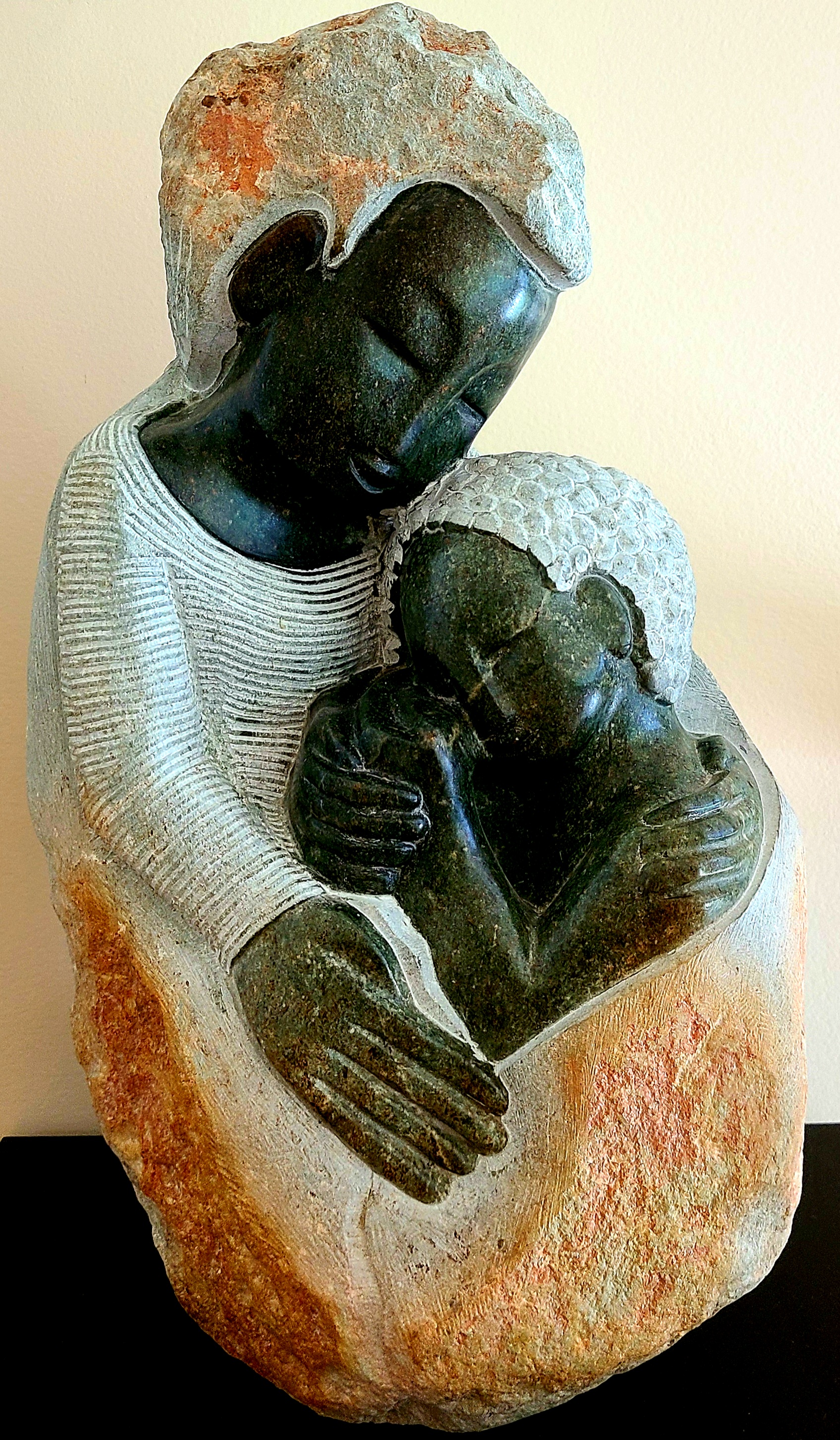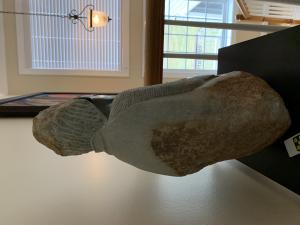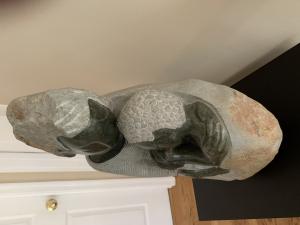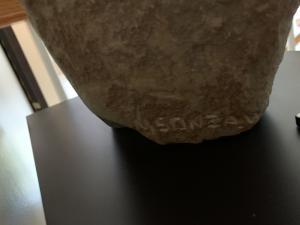Comforting
Washington Msonza
Sculpture
This black springstone sculpture depicts a common theme in Shona sculpture, the mother and the child, another example of which we have seen in Marshford Keneye’s sculpture (ID 52). Sculptures that juxtapose pairs in this way belong to the so-called “flow sculptures” (more on them in ID 52’s description) and are generally recognizable by the delicate and rhythmic movement of individuals shapes between each other. Most often, they are also quite abstract pieces. This piece by Msonza however, while not entirely belonging to the fine-art category of Shona works, is also not a highly abstract piece, as the shapes of the mother and child are rather life-like and easily discernible. What is interesting about this piece is the way the artist has utilized and retained the original appearance and shape of the springstone - left it almost untouched at the bottom, so that it forms a kind of protective envelope for the two figures that are rising out of it. This enhances the emotional response of the viewer and emphasizes the intimacy and the togetherness - the Shona tribal value “ukama” - that arises in close family relationships and connections.
SHONA SCULPTURE.
Stone carving has been a part of Zimbabwean culture since the 1200s and re-emerged as a modern sculptural tradition in the 1950s, known as the “Shona movement”. The driving force behind this art renaissance was Frank McEwen, director of the Rhodesia National Gallery from 1957 to 1973. McEwen encouraged and supported aspiring artists as they started the movement that would quickly become world-renowned. International collectors and critics were amazed at the rigour, spontaneity and originality of the works coming from an area of Africa which had none of the great sculptural heritage of West Africa and had been previously described as rather barren in terms of its visual arts. Contrary to other artistic tendencies and movements coming out of Africa in the post-colonial period, Shona sculptures were not looking back at the tradition of functional sculptural objects inspired by traditional customs and rituals, rather they found their sources in the present and created sculptures that blend the contemporary moment with the memories and dreams of their tribal past - the so-called “tribal consciousness” that was thematically encouraged by McEwen, alongside more modernist expressionist tendencies. Up to today, artists, without preliminary studies, spontaneously carve out semi-abstract shapes of birds and other animal or human forms imbued with ancestral symbolism, expressing an integral part of present day Shona folklore and religious beliefs.
Stone carving has been a part of Zimbabwean culture since the 1200s and re-emerged as a modern sculptural tradition in the 1950s, known as the “Shona movement”. The driving force behind this art renaissance was Frank McEwen, director of the Rhodesia National Gallery from 1957 to 1973. McEwen encouraged and supported aspiring artists as they started the movement that would quickly become world-renowned. International collectors and critics were amazed at the rigour, spontaneity and originality of the works coming from an area of Africa which had none of the great sculptural heritage of West Africa and had been previously described as rather barren in terms of its visual arts. Contrary to other artistic tendencies and movements coming out of Africa in the post-colonial period, Shona sculptures were not looking back at the tradition of functional sculptural objects inspired by traditional customs and rituals, rather they found their sources in the present and created sculptures that blend the contemporary moment with the memories and dreams of their tribal past - the so-called “tribal consciousness” that was thematically encouraged by McEwen, alongside more modernist expressionist tendencies. Up to today, artists, without preliminary studies, spontaneously carve out semi-abstract shapes of birds and other animal or human forms imbued with ancestral symbolism, expressing an integral part of present day Shona folklore and religious beliefs.
Height: 19
Width: 13
Depth: 6
Phoenix, AZ
Harare, Zimbabwe
*Material: The sculpture is carved out of springstone, a very hard member of the serpentine stone family, all of which are locally sourced in Zimbabwe. It is a beautiful dark stone, that can be polished to a high shine because of its density and presents a much bigger challenge to sculptors than other softer varieties of serpentine. As with other stones that are mined for the purpose of sculpting, springstone is mined by hand on communal lands and mostly found in northern Zimbabwe.
*Technique: These Zimbabwean sculptures are made strictly with hand, no power tools are used at any stage of the process and generally, everything is created free-form, ie. there are no preliminary sketches. The tools consist of hammers, points, chisels, rasps and chasing hammers, and the finishing of each sculpture takes almost as long as the process of creating it. The smooth effect is achieved by “washing” the sculpture, using wet and dry sandpaper and if the artist wants a high polish on the stone, the stone is heated and covered with wax (for a more detailed description of the sculpting process, see ID 48)
Washington Msonza was born in 1966 in Domboshava where he attended primary school. He then moved to Chitungwiza to attend secondary schooling. While in school, he spent most of his time watching his brother-in-law Albert Mamvura also a sculptor, whose workshop was close to his house. In 1988 Msonza began assisting Albert full time, while simultaneously gaining experience by watching other well known artists in the area including Gedion Nyanhongo, Biggie Kapeta and Locardia Ndandarika.He began by sculpting smaller works, and later began creating life-size sculptures.
Washington's great-aunt Locardia Ndandarika conveyed to him the ability to develop a feeling for what he calls ”Imagination of the stone’s soul” or the capability to foresee a hidden sculpture in the unhewn stone. An important thematic foundation of inspiration for Washington lies in the Shona myths which were told to him during childhood. He preferably chooses Black Serpentine and Springstone as media for his sculptures, contrasting polished and differently hewn unpolished surfaces. His graphic figures radiate a deep inner power offering interesting perspectives through the unique three-dimensional qualities.
Washington Msonza’s work can be marveled at galleries in the USA, South Africa, the Netherlands, Germany and Zimbabwe. His early work can be seen at Nhukutu Gallery, in the Chapungu Sculpture Park and in Springstone Gallery. In 1991 he participated in the annual heritage exhibition of the Zimbabwe National Gallery. In 2000, Msonza represented Zimbabwe in the Changschun International Sculpture symposium in China.




